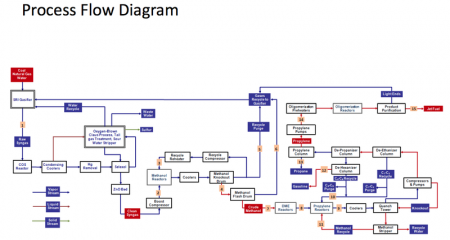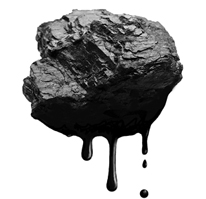Dec
21
SRI International Develops a New Coal To Liquid Fuel Process
December 21, 2011 | 9 Comments
Make no mistake here; SRI International has the brainpower and skill set to come up with workable and commercial ideas that have scale in mind from the start. Robert Wilson, Ph.D., director, Chemical Science and Technology Laboratory, SRI International said in the press release, “The implications of this research are expansive, including enhancing US energy security through the use of domestic carbon sources. The process can also dramatically reduce the environmental footprint associated with alternative transportation fuels.”
Simply put, SRI has a method to make use of the dense proportion of carbon in coal and reform it with high content of hydrogen in natural gas to make liquid hydrocarbon products. For the U.S. that has major energy security implications.
SRI’s promising new way to produce liquid transportation fuels from coal does not consume water or generating carbon dioxide. The hydrogen that water provides in other processes is substituted by the natural gas. With the energy requirement for hydrogen splitting from the water absent and the combustion of the coal the process reduces the CO2 produced.
The natural gas for water substitution also reduces the need to add energy to drive the gasification reaction, and results in the use of a smaller gasifier. In conventional coal to liquids approaches, energy is supplied by burning a portion of the coal feed, which then produces carbon dioxide. SRI’s approach makes it economical to use carbon neutral electricity, such as nuclear, hydro, or solar as a source of additional energy.

SRI Coal to Liquid Fuel Process Flow Diagram. Click image for the largest view. Image Credt: SRI International.
The new SRI process uses the hydrogen in the natural gas to convert coal making an uprated hydrogen rich syngas (a mixture of carbon monoxide and hydrogen). The coal first decomposes into volatiles and char while CH4 is converted into CO/H2 mixtures; the char is converted into CO/H2 mixtures via steam gasification on longer time scales. The syngas is first converted into methanol that can then be efficiently processed to make the desired transportation fuels.
Based on data from their bench-scale tests, SRI engineers estimate that the capital cost for a full-scale plant using the new process would be less than half that of a conventional coal-to-liquids (CTL) plant that uses the familiar and common process called Fischer-Tropsch Synthesis (FTS). FTS produces only a small fraction of the hydrocarbons needed for fuel and requires extensive recycling.
SRI has performed a series of analyses to examine the environmental impact of the technology under several scenarios. Conventional diesel comes in at 389 gCO2/mile, conventional FTS coal-to-liquids diesel at 830 gCO2/mile; and the SRI synthetic fuel at 326 gCO2/mile when using carbon-neutral electricity power. Based on their analyses, if diesel were produced using biogas as the natural gas source for the methane, the resulting emissions would be 190 gCO2/mile and the product would qualify as an alternative fuel under the revised Renewable Fuels Standard of the Energy Independence and Security Act of 2007. The Act requires alternative fuels to meet a standard of 50-percent reduction of greenhouse gas emissions compared to other fuels. That will get the attention of the coal folks.
Ripudaman Malhotra, associate director of SRI’s Chemical Science and Technology Laboratory presented the process at the 28th Annual International Pittsburgh Coal Conference pointing out the SRI process converts all the carbon to product, reduces capital cost, has adjustable syngas ratios to produce CO + 2H2, ideal for methanol; and uses efficient COTS (commercial off-the-shelf) technology for the methanol to JP-8 conversion.
SRI estimates the efficiency of its CTL plant at 67% – significantly higher than traditional CTL plants, mostly because it is converting 100% of the carbon feed into product and it utilizes electricity generated off-site. Accounting for the heat rate of generating that electricity from a traditional coal plant would still result in a plant efficiency of 47%.
But those efficiencies are a bit misleading – The cost per gallon for the SRI diesel fuel product is calculated at $2.81. That’s still higher than FTS at $2.14, where virtually all the energy comes from raw coal and a great share of the carbon is lost to CO2 in making the fuel and lots of energy goes to getting the hydrogen from water.
If the goal is low investment, downsized installations with low emissions and full use of the raw materials the SRI process is quite attractive. That plus the process itself offers more than the middle distillates of diesel and jet fuel. There’s crude methanol, gasoline, propylene, and propane as well – plus some mineral ash.
The SRI process likely has commercial legs. Whether or not a facility is built will consider the raw materials cost along with the investment. Another question comes to mind when looking over the process flow diagram. Would any of the concepts here transition to the oil shale deposits of the western U.S.?
Comments
9 Comments so far




This process looks like a much more environmentally friendly way to extract energy out of Coal than any other I have seen.
There are trillions of barrels of oil equivalent in each of these:
North American coal
North American methane
North American bitumens
North American kerogens
North American methane hydrates
North Americans simply need to eject Mr. Obama and his gang of energy starvationists from Washington DC, then rev up the nuclear regulatory commission to do its job so as to get advanced nuclear fission — with advanced fuel cycles — out there.
Using unlimited advanced fission process heat (950 C) and electricity, we can convert just about anything to anything, and to hell with EROEI!
I am not naysaying here, but for a few years now the University of Texas-Arlington has been saying they have a sure-fire, can’t miss way to make liquid fuel from brown coal, ready for instant commercialization.
I wonder what happens to all of these breakthroughs?
There is no mystery there, Benjamin. It costs billions of dollars to build these gasification plants for CTL, GTL, etc. Shell invested over $18 billion in its Pearl GTL F-T plant in Qatar. Profits from the Pearl plant are expected to be about $6 billion a year, by the way.
SRI says its capital costs will be half those of conventional F-T, but that is still a lot of money to sink into a plant.
Smart investors understand that there is still a lot of crude oil accessible — if only the pathetic oil sheikdoms, Latin nations, and the Russians would invest in infrastructure. But they don’t, because of corruption siphoning off profits — and because there is always the danger of overproduction, which leads to oil price crashes. Very bad for them, they have learned from many previous experiences.
So what, you ask? Why spend billions to produce oil substitutes when spending less money on oil infrastructure can get you a lot more crude — at least for the time being.
Eventually, to meet global demand, investors may have to put out billions for CTL, GTL, BTL, KTL, etc. But they don’t want to do it if they might be undercut by national oilcos who decide to upgrade their production.
Al Fin-
Agreed, but the Texas guys say they could build a small plant and make money.
I showed this article to a good friend of mine who worked at the Sasal South African ‘Coal To Liquids’ (CTL) plant for several years as one of their lead chemical engineers.
This is his rsponse:
“Keeping with the proper tone for the season, Bah. Humbug.
This is nothing but a marketing press release about a concept idea. SRI must need some publicity badly!
It’s a lot of big steps to go from a bench scale concept (“Based on data from their bench-scale tests”) to successively larger pilot plants to small scale commercial to an economical full scale plant – maybe in 10 years of further development they might have something viable to tout. And a high temperature, electric-heated gasifier – that ought to be quite the trick to successfully develop and commercialize. In my opinion, the biggest headache in the operating CT-something units is the gasification step – the gasifier designs used in South Africa have gone through nearly half a century of almost continuous design changes & only recently might be considered reasonable reliable – last I heard they were still sparing one gasifier for every four operating units just to maintain design thru-put on the facilities. Keep in mind, that Sasol is widely recognized as having the most reliable gasifier design which doesn’t say much about everyone else’s designs – although we don’t know much about those in China – mostly operating to make chemical feedstocks.
How about these statements from the press release: “…fuels from coal does not consume water” and “the char is converted into CO/H2 mixtures via steam gasification” Where is the steam (H2O) coming from to provide most of the oxygen to make the CO from the coal’s carbon? Can steam be made from something besides water?”
The SRI idea is cool but when are they going to put it to the real world. If they consider going big or if anyone knows of F-T process plant suppliers please contact me on andrewkolobeatgmaildotcom
hello dear friend
I’m Reza Maleki from Iran and I work in NABpasmand company.
I have some question about CTL pilot device
do you know famous company that they do CTL project?
I want to buy one set of CTL pilot device.
best regard
I’m Musa Maseko from Eswatini. I am interested in a supply as well as installation costs for a CLT plant that would convert the extracted liquid oil into diesel for running at least 10 x 8.3Mwatts generators 24/7. There is more than enough coal as a raw material. Thank you.